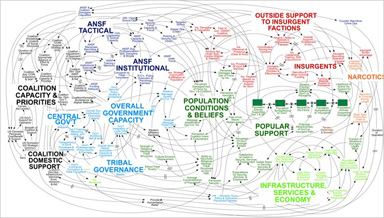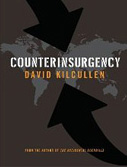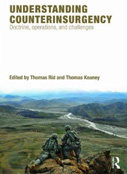Here is the latest edition of
my column at Foreign Policy:
Topics include:
1) Have the U.S. military's unconventional warriors defined themselves out of a job?
2) If you can't know the future, how do you prepare for it?
Have the U.S. military's unconventional warriors defined themselves out of a job?
What exactly is unconventional warfare? The U.S. military's special operations warriors have struggled with the definition for decades. To some, unconventional warfare encompasses the entire gamut of activities off the traditional battlefield, including support for foreign militaries, support for friendly guerillas, and behind-the-lines reconnaissance and raiding. Doctrinal purists object to this notion. To them, unconventional warfare means something very specific -- support for resistance movements battling governments hostile to the United States. Last year, the United States Army John F. Kennedy Special Warfare Center and School organized a conference attended by all of the stakeholders in the U.S. special warfare community for the purpose of finally settling on a definition. This they did. But in doing so, did they made unconventional warfare completely unusable as a tool for policymakers?
Here is the new approved definition: "activities conducted to enable a resistance movement or insurgency to coerce, disrupt or overthrow a government or occupying power by operating through or with an underground, auxiliary and guerrilla force in a denied area."
The idea of the United States supporting a resistance movement harkens back to U.S. support for French, Yugoslav, and other partisans resisting German occupation during World War II. During the Cold War, Green Berets prepared to drop into Eastern Europe to organize resistance if the Soviet army were to invade Western Europe. But the concept of unconventional warfare was later tarnished by the consequences of U.S. support for the Shah of Iran's overthrow of the Iranian government in 1953, failed meddling in Cuba in the 1960s, and the Contra war in Nicaragua in the 1980s. Unconventional warfare has since had to achieve a very high burden of proof to defend its legitimacy.
With the new definition now written into various U.S. Army field manuals, special operations units will begin to implement training programs to prepare U.S. forces to execute such a mission if called on to do so. But if the special operators are preparing for something that is either politically unrealistic or that purposely avoids the most dangerous threats to the United States, will the unconventional warriors have defined themselves out of a job?
Col. David Witty, who led last year's effort to define unconventional warfare, rejects these arguments. He notes that the definition targets governments or occupying powers and not non-state actors, who many analysts believe to be the most dangerous threat. Witty asserts that the new definition in no way restricts the ability or means for special operations forces to attack, in alliance with a resistance movement, non-state actors like al Qaeda. According to Witty, such a campaign would fall under counterterrorism, an activity separate from unconventional warfare.
More broadly, is it politically realistic to believe that the United States might ever again "coerce, disrupt or overthrow a government or occupying power"? For Witty, that is a decision for policymakers, and not soldiers, to make. He considers the use of unconventional warfare at least as likely as the clash of regular armies in open warfare, a scenario for which most would agree the U.S. military should also be prepared.
Although it has a troubled past, the appeal of unconventional warfare as a policy option is likely to rise. Supporting insurgents to overthrow an unsavory government seems like a bad idea. But that idea may seem much less bad when compared to all of the alternatives, especially those the U.S. government has tried recently and will wish to avoid trying again. The job for Witty and his special operations colleagues is to make sure policymakers have a usable option should they call for it.
If you can't know the future, how do you prepare for it?
After spending years retooling itself for counterinsurgency campaigns in Iraq and Afghanistan, is the U.S. Army now unprepared for high-intensity warfare involving an adversary equipped with tanks, artillery, and missiles? In the summer of 2006, the Israel Defense Forces, having spent years immersed in counterterrorist constabulary duties, found themselves bloodied by highly skilled Hezbollah fighters armed with sophisticated weapons and prepared for high-intensity operations.
Some U.S. Army officers fear the United States may be similarly unprepared. The need for foot soldiers in Iraq and Afghanistan has diverted soldiers in the armor, artillery, and other branches to serve as infantrymen, depriving them of the experience they require to master their original fields. Three Army colonels, all very successful counterinsurgency commanders in Iraq, declared in a paper they wrote for the Army chief of staff that the artillery branch was nearly untrained and essentially unprepared for large-scale combat. Col. Gian Gentile, an outspoken combat veteran of Baghdad and now a history professor at West Point, declared that "The Armor Corps in the American Army is gone." Gentile asked:
But what if the American Army has to fight somebody in the future beyond insurgents laying IEDs and small arms ambushes that is usually handled effectively by infantry platoons? What if a heavy Brigade Combat Team in Iraq was told to pick up and head east and do a movement to contact into a threatening country?
Could we do it? It would be hard to do such an operation without the intellectual framework of an Armored Force that the American Army used to have, but of late has gone away. It will be hard, very hard to get it back. Competent field armies, skilled in all-arms warfare, are not made overnight.
Gentile's questions are mostly philosophical, addressing what he believes is a new and disturbing state of mind among top Army officers. But the questions raised by all four colonels also address specific technical questions for which the Army should have quantitative answers.
The Army should be able to tell the secretary of defense or the chairman of the Senate Armed Services Committee (assuming they were interested) how many heavy brigade combat teams (those equipped with tanks, mechanized infantry, artillery, etc.) have demonstrated their proficiency in high-intensity combat to Army training standards within, say, the past three months. The Army should also be able to report how many additional heavy brigade combat teams would be similarly combat ready in one month, three months, six months, and so on, should a situation requiring that capability arise.
Hopefully, the Army has answers to these questions (which undoubtedly are secret). Whether the answers are alarming to officials in the chain of command or to congressional oversight committees are judgments in risk management. These judgments include assessing the size and qualities of potential threats, their probabilities, and their associated warning times. In 2006, Israeli policymakers either misjudged these factors or overestimated the high-intensity combat readiness of their forces.
The concerns raised by the four colonels are part of a larger question about the U.S. military's ability to adapt to strategic surprises of any kind. Retooling for counterinsurgency (which took at least four years) has left the Army much less prepared for other contingencies. Knowing how many units are ready for various kinds of wars is important. Perhaps even more important is building a military force that is specifically designed to rapidly retool itself regardless of the surprise.



